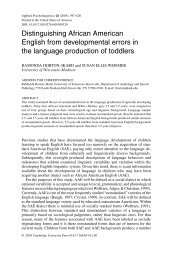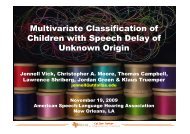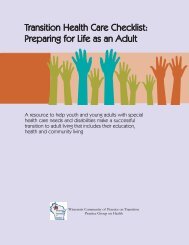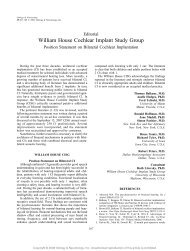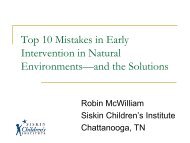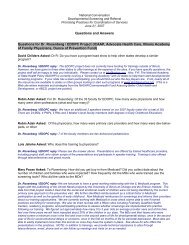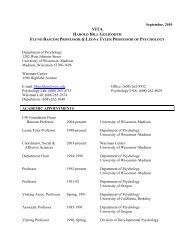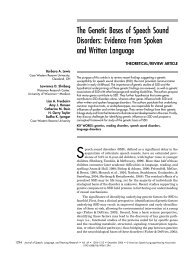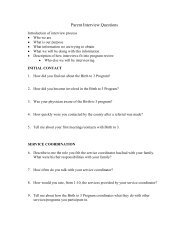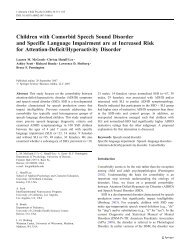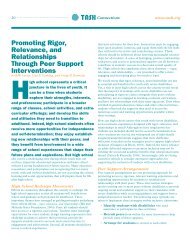Music and Language: A Developmental Comparison - Waisman ...
Music and Language: A Developmental Comparison - Waisman ...
Music and Language: A Developmental Comparison - Waisman ...
Create successful ePaper yourself
Turn your PDF publications into a flip-book with our unique Google optimized e-Paper software.
Learning <strong>Music</strong> <strong>and</strong> <strong>Language</strong>305volved in the perception of both speech <strong>and</strong> music. However, the vast storesof knowledge pertaining to these separate domains may be stored in separateplaces in the brain. Patel argues that when neurological patients presentwith what appear to be domain-specific deficits in speech or music, whathas actually been lost is not the processing capacity, but the knowledgerequired to engage it as a mature comprehender or producer. On this hypothesis,basic similarities between infant speech <strong>and</strong> music learning mechanismswould be expected. To test this hypothesis, Patel suggests a morecareful examination of neuropsychological patients who present with disordersapparently specific to one domain.Another way of looking at this controversy is that a distinction must bemade between the putative modularity of mechanisms used to learn in differentdomains <strong>and</strong> the evidence for modularity of functions in the maturelearner. Although the data supporting separate cortical regions subservingsome aspects of musical <strong>and</strong> linguistic processing in adults are overwhelming,it is still quite plausible that young children may bring some of thesame skills to bear on learning in each domain. The brains of young childrenare quite plastic <strong>and</strong> show a remarkable ability to reorganize in theevent of head trauma, which suggests that, whatever the arguments forfunctional localization in adults, it is not fixed in children. Furthermore,differences between the brains of musicians <strong>and</strong> nonmusicians have alreadybeen demonstrated (e.g., Schlaug, 2003), <strong>and</strong> it is tempting to concludefrom this that experience has a profound effect on cortical organization.However, this hypothesis requires further testing, perhaps through a systematicinvestigation of less experienced brains. To date, relatively few imagingstudies have been done with young children, in part because of therisks associated with PET. Luckily, with the advent of less invasive techniqueslike fMRI, it has become possible to see whether imaging resultsshowing modularity in adults can be replicated in children. Efforts in thisdirection have been aided by a recent study by Kang <strong>and</strong> colleagues, whichshowed that st<strong>and</strong>ard methodological procedures for h<strong>and</strong>ling adult fMRIdata, such as st<strong>and</strong>ardizing it to a common stereotactic space, are adequatefor working with child imaging data (Kang, Burgund, Lugar, Petersen, &Schlaggar, 2003). Early results suggest that some language-related functionsdo show age-related organizational differences that are unrelated toperformance level (Schlaggar et al., 2002). However, more detailed researchmust be done using auditory musical <strong>and</strong> linguistic stimuli in order to betterunderst<strong>and</strong> the modularity issue as it pertains to music <strong>and</strong> language.The theoretical issue of modularity aside, it is also the case that metaphorplays a powerful role in directing our thinking <strong>and</strong> suggesting newinsights. Whether or not music <strong>and</strong> language share common ancestry orcircuitry, thinking about them as related functions may still be quite helpfulin generating novel hypotheses that can help us to better underst<strong>and</strong>



